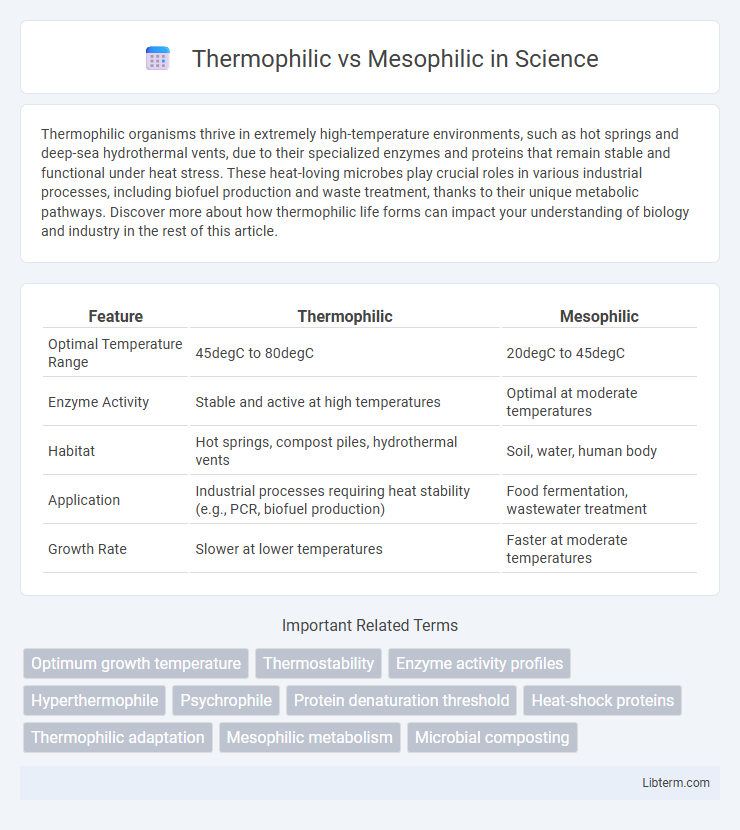Thermophilic organisms thrive in extremely high-temperature environments, such as hot springs and deep-sea hydrothermal vents, due to their specialized enzymes and proteins that remain stable and functional under heat stress. These heat-loving microbes play crucial roles in various industrial processes, including biofuel production and waste treatment, thanks to their unique metabolic pathways. Discover more about how thermophilic life forms can impact your understanding of biology and industry in the rest of this article.
Table of Comparison
| Feature | Thermophilic | Mesophilic |
|---|---|---|
| Optimal Temperature Range | 45degC to 80degC | 20degC to 45degC |
| Enzyme Activity | Stable and active at high temperatures | Optimal at moderate temperatures |
| Habitat | Hot springs, compost piles, hydrothermal vents | Soil, water, human body |
| Application | Industrial processes requiring heat stability (e.g., PCR, biofuel production) | Food fermentation, wastewater treatment |
| Growth Rate | Slower at lower temperatures | Faster at moderate temperatures |
Introduction to Thermophilic and Mesophilic Organisms
Thermophilic organisms thrive at high temperatures ranging from 45degC to 80degC, often found in environments such as hot springs and compost heaps, where enzymatic activities are optimized for heat stability. Mesophilic organisms grow best between 20degC and 45degC, inhabiting moderate environments like soil, water, and the human body, with metabolic processes adapted to these temperatures. Understanding the distinct temperature preferences of thermophiles and mesophiles is crucial for applications in biotechnology, waste treatment, and microbial ecology.
Defining Thermophiles: Characteristics and Habitats
Thermophiles thrive at high temperatures between 41degC and 122degC, exhibiting enzymes and proteins adapted to maintain stability and functionality under thermal stress. These organisms are commonly found in extreme environments such as hot springs, hydrothermal vents, and compost piles, where heat concentrations support their growth. Thermophilic bacteria and archaea play crucial roles in biotechnological applications, including industrial enzyme production and biofuel generation.
Understanding Mesophiles: Key Features and Environments
Mesophiles thrive at moderate temperatures, typically between 20degC and 45degC, making them essential for processes like composting and wastewater treatment. These microorganisms exhibit optimal enzyme activity and cellular functions within this temperature range, supporting diverse ecosystems such as soil, human gut, and freshwater environments. Their metabolic versatility enables them to efficiently decompose organic matter, contributing significantly to nutrient cycling and biodegradation.
Temperature Ranges: Thermophilic vs Mesophilic Microbes
Thermophilic microbes thrive at temperatures between 41degC and 122degC, commonly found in hot springs and compost heaps, whereas mesophilic microbes prefer moderate temperatures ranging from 20degC to 45degC, typical of soil and the human body. The optimal growth temperature for thermophiles usually lies around 60degC to 80degC, enabling their enzymatic activities to function efficiently under extreme heat. In contrast, mesophiles exhibit maximum growth at approximately 30degC to 40degC, aligning with environments that support diverse biological ecosystems.
Growth Conditions and Metabolic Pathways
Thermophilic microorganisms thrive at temperatures between 45degC and 80degC, utilizing specialized enzymes like thermostable DNA polymerases to sustain metabolic pathways optimized for high-heat energy production and substrate conversion. Mesophilic organisms grow best around 20degC to 45degC, relying on metabolic pathways adapted for moderate temperature stability, often involving conventional enzymes that function efficiently within this range. The differential enzyme structure and stability between thermophiles and mesophiles drive variations in their metabolic flux, influencing energy yields and substrate specificity under respective growth conditions.
Industrial Applications of Thermophiles and Mesophiles
Thermophilic microorganisms are widely employed in industrial applications requiring high-temperature processes, such as biofuel production, waste treatment, and enzyme manufacturing, due to their ability to thrive at temperatures above 45degC, enhancing reaction rates and process efficiency. Mesophilic microbes, optimal at moderate temperatures between 20degC and 45degC, are commonly used in fermentation industries, including dairy, brewing, and pharmaceuticals, where controlled, lower-temperature environments ensure product stability and quality. The distinct thermal preferences of thermophiles and mesophiles enable tailored bioprocesses, optimizing microbial performance based on temperature-sensitive industrial needs.
Advantages and Limitations of Each Microbial Type
Thermophilic microbes thrive at high temperatures (45-80degC), offering advantages such as faster metabolic rates and enhanced degradation of complex organic materials, ideal for industrial composting and biofuel production, but their high-temperature requirement limits their use in cooler environments and increases energy costs. Mesophilic microbes function optimally at moderate temperatures (20-45degC), providing stable and efficient breakdown of organic matter in typical environmental conditions with lower energy input, though they exhibit slower reaction rates and less tolerance to harsh conditions compared to thermophiles. The choice between thermophilic and mesophilic microbes depends on process goals, energy availability, and environmental constraints, balancing the speed and efficiency of thermophiles against the adaptability and energy savings of mesophiles.
Thermophilic vs Mesophilic in Waste Treatment
Thermophilic waste treatment operates at temperatures between 50-65degC, accelerating microbial metabolism and pathogen destruction compared to mesophilic processes, which function optimally at 20-45degC. Thermophilic digestion enhances organic matter breakdown and biogas production efficiency, making it suitable for high-strength waste streams, while mesophilic treatment offers greater process stability and lower energy requirements. Choosing between thermophilic and mesophilic waste treatment depends on balancing treatment speed, energy consumption, and system robustness specific to the waste characteristics and operational goals.
Impact on Biotechnology and Research
Thermophilic microorganisms, thriving at temperatures above 45degC, produce heat-stable enzymes crucial for industrial applications such as PCR, biofuel production, and waste treatment, enhancing process efficiency and durability. Mesophilic microbes, active at moderate temperatures (20-45degC), are widely used in fermentation and bioremediation, offering versatility and ease of cultivation for biotechnology research. The distinct metabolic pathways and enzyme profiles of thermophiles and mesophiles drive innovation in genetic engineering, industrial microbiology, and environmental biotechnology.
Choosing Between Thermophilic and Mesophilic Processes
Choosing between thermophilic and mesophilic processes depends on factors such as temperature ranges, processing speed, and energy efficiency. Thermophilic processes operate at higher temperatures (50-65degC), offering faster pathogen destruction and biogas production but require more energy input and greater temperature control. Mesophilic processes function at moderate temperatures (30-40degC), providing greater process stability, lower energy costs, and suitability for a wider range of waste types.
Thermophilic Infographic

 libterm.com
libterm.com